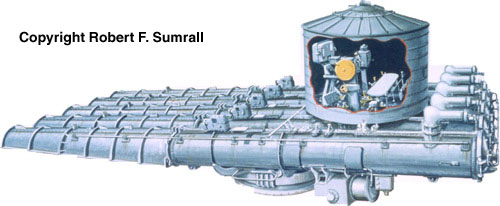The 21–in Quintuple MK 14 and MK 15 Torpedo Tubes
By Robert F. Sumrall (DD 762)

From their inception, destroyers have always carried a heavy torpedo battery for their size and tonnage. The 21-inch torpedo was introduced in the O’BRIEN(DD-51) class of 1912, one of the immediate predecessor classes of the flush-deck four-stackers which began with the CALDWELL (DD 69)class of 1915. Torpedoes were fired from twin tube mounts in the O’BRIEN-class and from triple tube mounts in the CALDWELL-class. The FARRAGUT (DD-348) class of 1933, the first of the new destroyers, was equipped with quadruple tube mounts which remained standard until the BENSON (DD-421)/GLEAVES (DD-423)classes of 1937 when the quintuple tube mounts were introduced. They then became the standard and were also used on the FLETCHER (DD-445) class, ALLEN M. SUMNER (DD-692) class, and GEARING (DD-710) class.
Since the 1950s, the torpedo, as launched from surface vessels, has evolved primarily into an ASW weapon. The varied sizes and shapes of the new torpedoes required different delivery systems and devices, which eventually replaced all of the original tube mounts.
The MK 14 and MK 15 torpedo tube mounts were designed for launching the 21-inch MK 15 torpedo. The tubes were mounted in a trainable, quintuple arrangement that included the following major components: the stand, saddle, barrels, controls, heating equipment, and a blast shield (MK 15 only). Except for the shield, which was installed to protect the operating crew from nearby 5-inch gun blast, the MK 14 and MK 15 mounts were identical. The stand and saddle were the equivalent of a base ring and carriage in a gun mount. The stand was bolted to the deck and housed the training circle and bearings for the saddle.
The saddle supported the five barrels in a parallel arrangement and was secured to the stand with hold down clips. The barrel assemblies, consisting of the main barrel, door, and spoon extension, were bolted to the saddle through two mounting ring flanges. The doors were on the aft or breech end of the barrel and hinged to avoid interference with each other. The spoon extensions on the forward end of the barrels were hinged and could be folded backwards on top of the barrel providing access to the torpedo warhead. The controls for setting the torpedo gyro, depth, and speed were fitted atop the barrels just aft of the mounting ring flanges. The settings were made electrically. Two rows of barrel heaters were fitted to the underside of the barrels at the controls in the area of the torpedo mechanisms.
A firing mechanism was fitted to the top of each tube at the aft end just forward of the breech doors. Torpedoes were launched individually by the ignition of a charge of black powder from an impulse cartridge inserted into the firing mechanism. The cartridge could be fired by manual or hydraulic percussion or electrically. The operating mechanism of the torpedo was started mechanically by a tripping latch when the torpedo left the muzzle of the barrel.
Torpedoes were loaded through the doors at the breech end of the tubes. A retractable loading crane and chain fall held the torpedo while alignment and orientation with the tube was established. The torpedo was then manually pushed into the tube.
The MK 15 torpedo was 21-inches in diameter, 24 feet long, and weighed 3,850 pounds.
